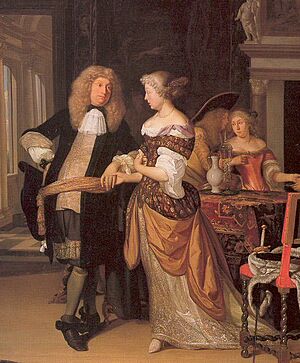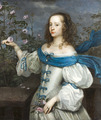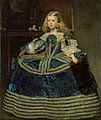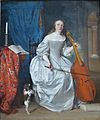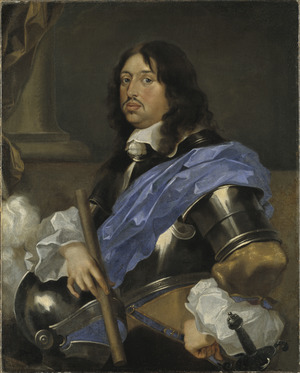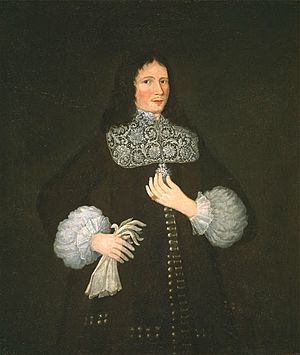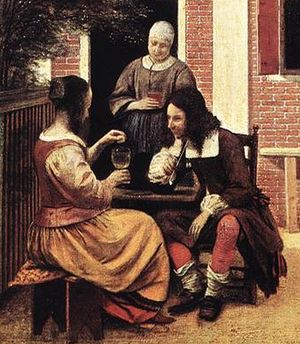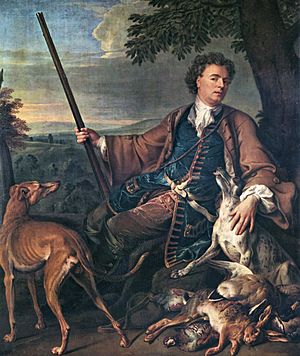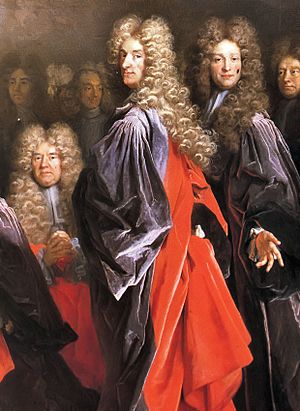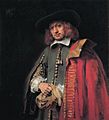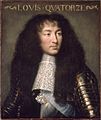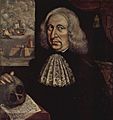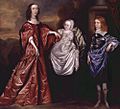Baroque Fashion 1650–1700 facts for kids
Get ready to explore the exciting world of fashion from 1660 to 1700 in Western Europe! This time was full of quick changes in clothing styles. People often call the look of this era "Baroque."
During these years, the periwig became super important for men's fashion. It was a must-have item!
Contents
Women's Fashion: What They Wore
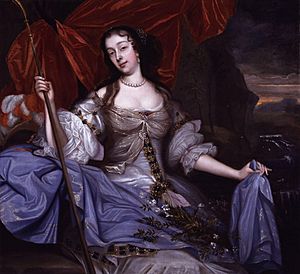
Changing Styles for Women
The wide, high-waisted look from earlier times slowly changed. Women started wearing clothes with a long, straight shape. Shoulders became wider. Sleeves were full and loose, ending below the elbow. Later, they became longer and tighter.
Women wore tight corsets. Their necklines were low and wide, with dropped shoulders. In the later years, the overskirt was pulled back and pinned up. This showed off the petticoat, which was often very fancy.
Fashion in Spain and Holland was a bit different. Spanish court fashion did not follow the trends from France and England. Wealthy Holland also kept its own simple styles. This was especially true for headwear and hair.
Hair and Hats for Ladies
At the start of this period, women wore their hair in a bun at the back. Curls framed their faces. These curls became more detailed in the 1650s. Then they grew longer, hanging nicely on the shoulders.
In the 1680s, hair was parted in the middle. It was styled high over the temples. By the 1690s, hair had no part. Rows of curls were stacked high over the forehead.
This tall hairstyle often had a fontange on top. This was a frilly cap made of lace. It was wired to stand up in vertical layers. Streamers hung down on each side. It was named after Angélique de Fontanges. This cap was popular from the 1690s into the early 1700s.
Women's Fashion Gallery: 1650s
- German fashion in 1650 shows a smooth, tight satin top. It had dropped shoulders. Slashed sleeves were held with jewels.
- Margareta Maria de Roodere wears a salmon-colored dress in 1652. A sheer scarf was tied around her shoulders.
- Mary, Princess of Orange wears a satin dress with a long, pointed top. Her skirt had many tiny pleats, 1652.
- Maria Theresa of Spain wears the guardainfante in 1653. This wide skirt style stayed popular in Spain longer than elsewhere.
- The Swedish countess Beata Elisabet von Königsmarck wears a white silk dress. It has a long, tight top and wide, double puffed sleeves.
- This young Dutch girl wears a rose jacket-top and a plain pink petticoat. Her hair is in a braid with small curls, 1658–60.
- Dutch fashion details from 1658 include pearls with a black ribbon. She wears a jacket-top with a matching skirt.
- Infanta Margarita of Spain is shown at eight years old. She wears the guardainfante in 1659.
Women's Fashion Gallery: 1660–1680
- English court dress from the 1660s. It is made of silver fabric with lace. From the Fashion Museum, Bath.
- Peter Lely shows Two Ladies of the Lake Family. They wear satin dresses over loose shirts. Their hair is in many ringlets.
- This Dutch lacemaker's jacket-top has dropped shoulders. It has full, three-quarter sleeves. Her indoor cap is embroidered, 1662.
- The very long, pointed top of about 1663 is clear in this painting. The sleeve is pleated at the shoulder and cuff.
- Inés de Zúñiga, Countess of Monterrey shows typical Spanish court fashion, 1665.
- The Infanta Margarita of Spain wears a black mourning dress. It has long sleeves, a cloak, and a hood, 1666.
- Two English ladies wear dresses with short sleeves. Underneath are shirt sleeves gathered into three puffs.
- Maria Theresa of Spain wears huge sleeves and large pearls, 1670. She has a mass of loose waves.
- Puritan influence shows in this Boston lady's portrait. She wears a lace-trimmed collar and a cap over her hair, 1671–74.
- Empress Eleonore of Pfalz-Neuburg wears a brocade dress. It has a very low waist and elbow-length sleeves, typical of the 1670s.
Women's Fashion Gallery: 1680s–1690s
- Mary of Modena, wife of James II of England, wears a dress with jeweled clasps, 1680. Her hair curls over her temples and shoulders.
- Dorothy Mason, Lady Brownlow in fashionable casual wear. Her dress is unfastened at the chest.
- Mary II wears 1688 fashion: a mantua (a type of gown) with cuffed sleeves. She has a wired lace fontange and pearls.
- Spanish court fashion around 1690 shows a long, stiffly corseted shape. It has a broad neckline and long sleeves.
- Mary II of England. By 1690, her hair was styled high over her forehead. Curls hung down behind.
- A French fashion plate shows a manteau or mantua, 1685–90.
- The Electress Palatine (Anna Maria Luisa de' Medici) in hunting dress, 1690s. She wears a long, coat-like jacket with wide cuffs.
- Comtesse de Mailly, 1698, wears court fashion. Her mantua has elbow-length cuffed sleeves. The trained skirt is looped back to show a petticoat.
- The mantua from Kimberly Hall is made of striped wool fabric. It has silver-gold embroidery, around 1690–1700.
Men's Fashion: What They Wore
Changing Styles for Men
After the Thirty Years' War ended, fashion in the 1650s and early 1660s became more relaxed. Military boots were replaced by shoes. Baggy breeches, short coats, and lots of ribbons became popular. This time was full of many changes.
In 1666, Charles II of England, following Louis XIV of France, made a new rule for court. Men had to wear a long coat, a vest or waistcoat, a cravat, a periwig, and breeches gathered at the knee. They also wore a hat outdoors. By 1680, this more serious, uniform-like outfit became the normal formal wear.
Men's Hairstyles
Throughout this time, men wore their hair long. Curls went past their shoulders. Bangs were usually combed forward over the forehead. Men had worn wigs before to cover thinning hair. But the periwig became a standard part of fashion thanks to King Louis XIV of France.
Men's Fashion Gallery: 1650s
- This coat from 1654 has many tiny buttons. A cloak trimmed with braid is worn over one shoulder.
- Coronation dress of Charles X of Sweden from 1654.
- Swedish industrialist Emanuel De Geer in an outfit from 1656. He wears a linen shirt and a doublet with slashed sleeves.
- Dutch fashions, 1658. White boothose and petticoat breeches.
Men's Fashion Gallery: 1660s
- In 1661, a short coat is worn over a large shirt. It has wide ruffles at the cuffs and a flat collar.
- Young Louis XIV of France wears a lace-bordered collar and a large wig over his armor, 1661.
Men's Fashion Gallery: 1670s–1690s
- Dutch fashions, 1671.
- Wedding suit of James II of England, 1673. From the Victoria and Albert Museum.
- Don Luis de la Cerda, later IX Duke of Medinacelli wears the long justacorps (a type of coat) from about 1684.
- Artist Thomas Smith, around 1690.
- A student from Leipzig in a fancy wig, around 1690.
Children's Fashion
Young boys wore skirts with doublets (jackets) or tops that fastened at the back. They wore these until they were breeched. This meant they started wearing breeches, usually between six and eight years old. They wore smaller versions of men's hats over coifs or caps. Small children's clothes often had leading strings at the shoulder. These were straps used to help them learn to walk.
-
Infante Afonso of Portugal, 1653.
Working Class Clothing
-
Checking for lice, 1662.


